Women’s History Month is a time to highlight and celebrate the contributions of women. This year, the designated theme for March 2022 is “Providing Healing, Promoting Hope.”
According to the National Women’s History Alliance (NWHA), the theme is “both a tribute to the ceaseless work of caregivers and frontline workers during this ongoing pandemic and also a recognition of the thousands of ways that women of all cultures have provided both healing and hope throughout history.”
The theme is a perfect summation of the collaboration between the Community Care HUB and the Community Care Agencies who employ Community Health Workers (CHWs). Currently, there are six women CHWs and three women Community Health Worker Supervisors who are doing amazing work. In their roles, CHWs meet HUB participants in their homes to connect them to needed social and medical services. By making those connections for participants, CHWs are constantly providing healing and hope.
One HUB participant stated her CHW “is a godsend” and “has gone above and beyond” in support.
During the COVID-19 pandemic, CHWs (about 71% are women) were frontline workers helping connect participants to telehealth, if needed, vaccinations, testing kits, and masks. While navigating the pandemic, CHWs continued helping participants with their normal health and social service needs as well.
The CHW workforce isn’t the only healthcare field dominated by women. Caregivers are primarily women as well, and provide health and social needs assistance to another person. The position can be paid or unpaid – which can happen when family members are assisting other family members.
According to the Family Caregiver Alliance, an estimated 61 percent of family caregivers are women.
Since women make up the majority of caregivers, paid or unpaid, they can see a variety of negative effects in health, finances, employment, and relationships.
In the healthcare field, the U.S. Census Bureau’s 2019 Median Earnings Table indicated that women make up 72.6% of the Healthcare Practitioners and Technical Occupations category. Although women make up the vast majority of the workers, they still earn 73.2% of what men earn in the healthcare field.
While the number of women working in the medical field has come a long way and women are the majority workforce, more effort needs made in equaling the pay gap.
CHWs, healthcare workers, and caregivers experience high burnout factors due to the stressful nature of the careers. Depression can also be a problem.
According to the National Institute of Mental Health (NIMH), an estimated 21 million adults in the United States have had at least one major depressive episode in 2020. Major depression is one of the most common mental disorders in the U.S.
The National Survey on Drug Use and Health conducted a 2020 study defining a major depressive episode as, “A period of at least two weeks when a person experienced a depressed mood or loss of interest or pleasure in daily activities, and had a majority of specific symptoms, such as problems with sleep, eating, energy, concentration, or self-worth.” In this study, no exclusions were made for major depressive episode symptoms caused by medical illness, substance use disorders, or medication.
21 million adults in the United States had at least one major depressive episode in 2020, according to NIMH. Women saw a higher prevalence of a major depressive episode at 10.5% compared to men at 6.2%. NIMH also estimated that 4.1 million adolescents aged 12 to 17 suffered from one major depressive episode. The prevalence of depression was higher in girls at 25.2% compared to 9.2% of boys.
Since women fill the majority of health care positions, they are also providing the majority of healing and hope. It’s time that more work be done to help provide women with equal healing and hope.
Women are the backbone of healthcare and caregiving. Women’s History Month, and every month, should be a time to celebrate the role women have undertaken and their influences in society and healthcare.
Sources:
https://www.caregiver.org/resource/caregiver-statistics-work-and-caregiving/
https://www.census.gov/data/tables/time-series/demo/industry-occupation/median-earnings.html
https://www.nimh.nih.gov/health/statistics/major-depression

